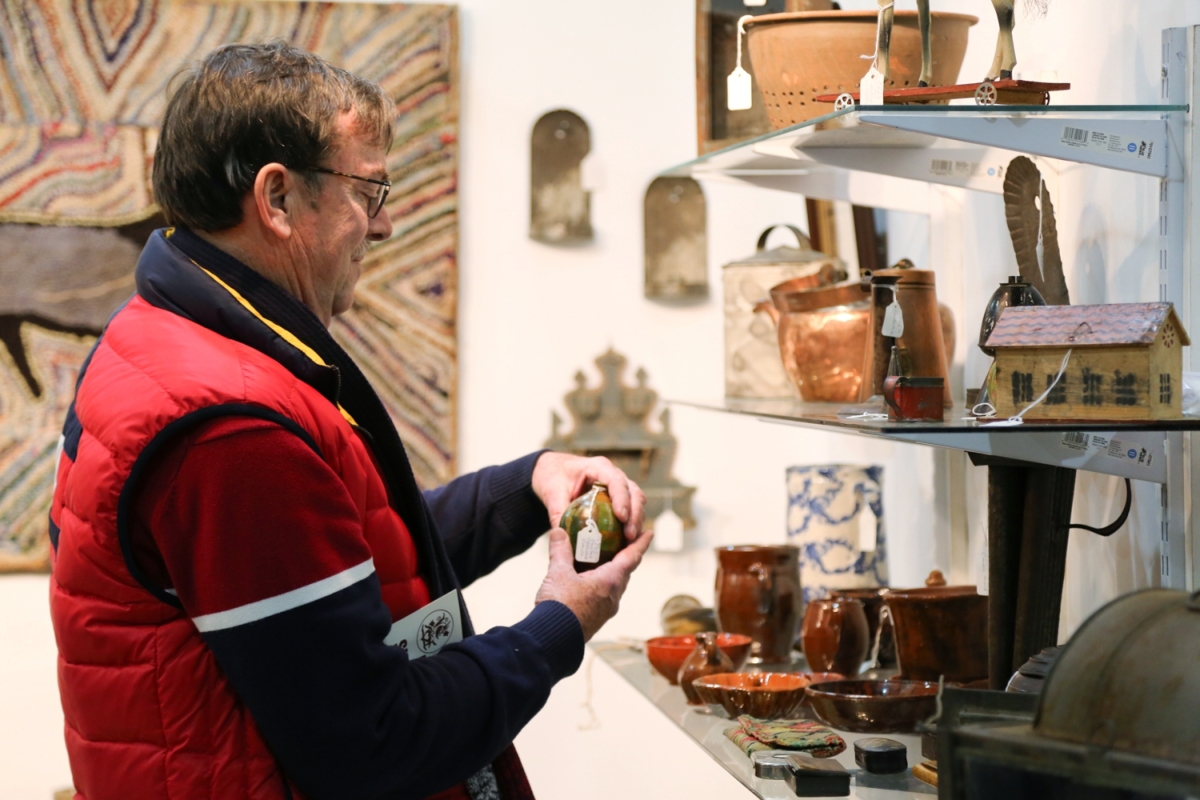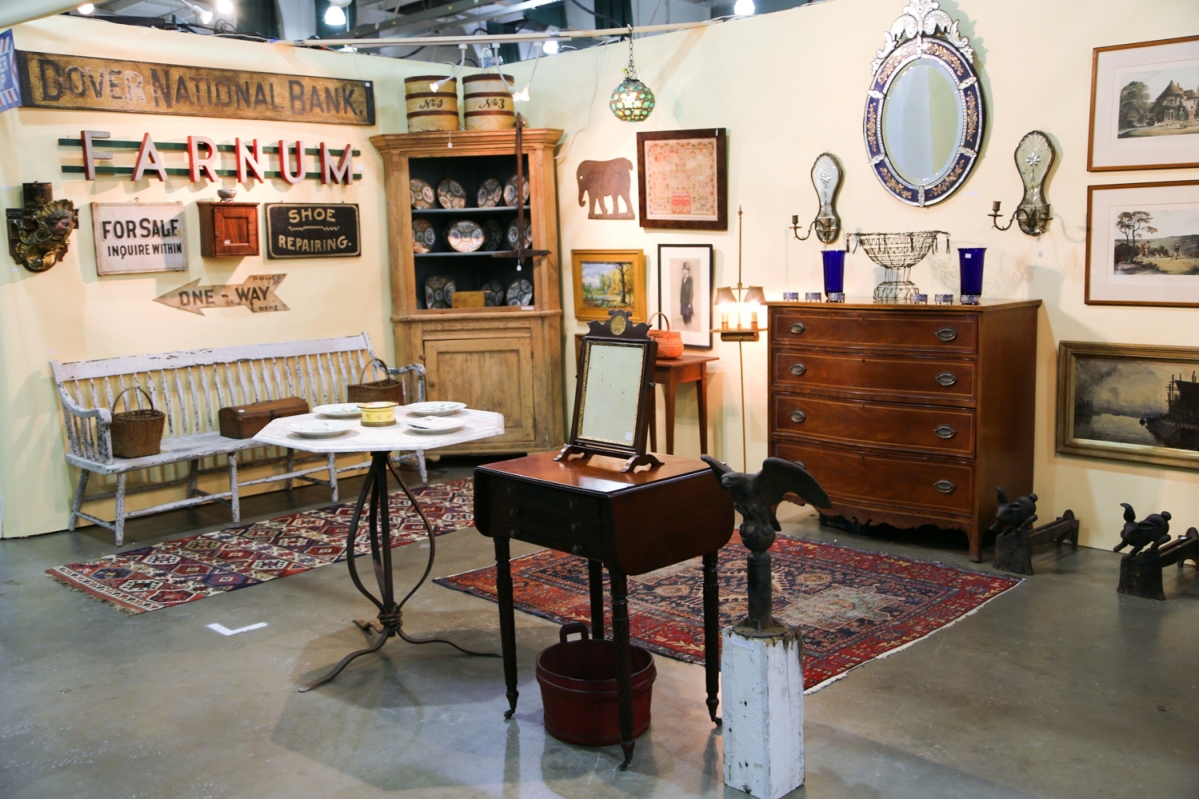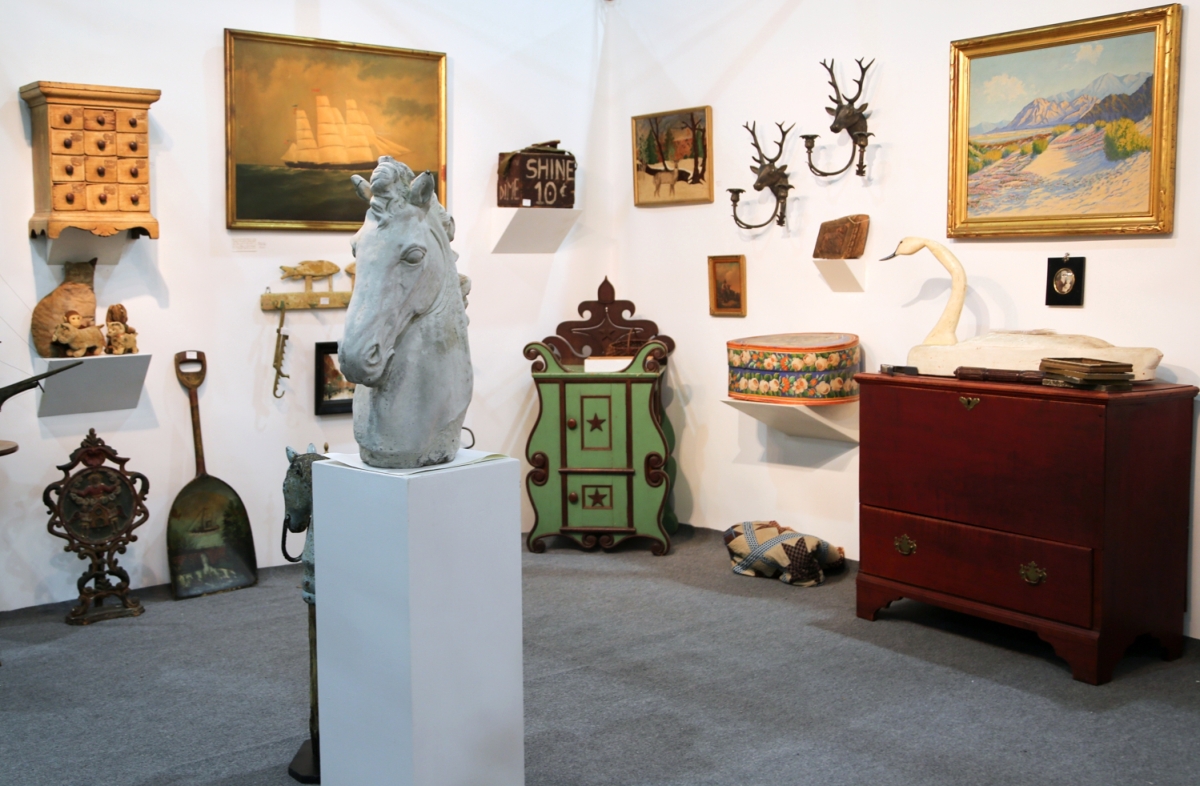Review and Photos by Greg Smith
YORK, PENN. – Despite the forecast of chill and snow, most dealers left warmly satisfied with Melvin “Butch” Arion’s 172nd edition of the Original Semi-Annual York Antiques Show and Sale, which alighted Memorial Hall East at the York Fairgrounds February 1-3. The show brought together its list of quality exhibitors – 88 of them this edition – to entice buyers with a display of all things American: fine art, furniture, clocks, jewelry, ceramics, objects, folk art, toys, primitives, carpets, textiles, advertising, weathervanes, glass and more.
As forecasters heralded in the polar vortex to the Midwest, more plainly known as winter weather, York saw temperatures in the teens and a 2- to 3-inch snowfall the night before the opening. A 1-inch slush covered the roads for the show’s opening day. This affected the gate on Friday, but not for the remainder of the weekend.
“I left my hotel room that Friday morning thinking the show was going to be a disaster,” show manager Arion said. “And when I went out to open the door and I saw the line, I was grateful. Saturday we had a good attendance and Sunday was not bad at all. I was pleased with the gate all three days; believe me, I was pleased.”
Dealers John Chaski and Chris Evans both reported seeing a more youthful crowd over the weekend.
“We noticed a lot of fresh faces we had not seen before, including some younger shoppers. We are a bit buoyed by that!” Evans remarked. The dealer counted among his sales an Amish crib quilt, an American carved architectural eagle, stoneware, redware and some smalls
“The crowd on Saturday was one of the largest I can remember in terms of a single day at York,” said Chaski. “There were a lot of fresh faces, and it skewed young by antiques show standards. I think that’s really encouraging.” he said, adding that the show was a mixed bag for him, as he sold a dozen gameboards, a slew of smalls and a few small pieces of furniture.

A miniature jug was worth taking a closer look at in the booth of Robert M. Conrad, Yeagertown, Penn.
Pat and Rich Garthoeffner, Lititz, Penn., reported a good show, doing business throughout the weekend. “We were very surprised at the crowds due to the bad weather, but York has very dedicated antiques buyers,” Rich said. “We sold all across the board: four hooked rugs, two Nantucket baskets, a variety of toys, a few pieces of jewelry and a child’s beaded Indian vest. We had reduced our prices as low as we could go and consequently sold a good amount.”
Rockingham, Vt., dealers Stephen Corrigan and Douglas Jackman counted up a bevy of sales. The dealers featured and sold quickly a 1797 broadside from a Newcastle, Del., tavern. The sheet was printed by S&J Adams, who were one of the first printers in Delaware, according to Corrigan. It was a rate list, agreed upon by the local courts, for lodging, alcohol, food and stable fees. Other sales included an early Nineteenth Century yellow-painted desk, an early cloth black rag doll, an Eighteenth Century flame-stitched purse, an early pine carving of a robin and a variety of early glass and China.
Hilary and Paulette Nolan exhibited a pencil post bed from Newburyport, Mass. It had its original red paint and was a full-size double. “It’s the nicest bed I’ve had in a long time,” Hilary said. The Falmouth, Mass., dealer also featured a set of six chairs made by James Tuttle of Salem, Mass. Tuttle’s chairs are recognizable from their serpentine crest rail. Nolan’s Tuttle chairs were in their original white and baby blue paint and dated to 1800-10. The dealer also featured a red-painted tea table, which descended in the Simms family from Boston. The table was circa 1740-50. “One of my favorite sales was to a couple who have a farm in Pennsylvania and a summer house on Campobello Island, New Brunswick,” Hilary said. “They bought a wonderful large carved seagull sculpture with a small codfish carved into the base. Loved the piece and the people.”
Steven Still, Manheim, Penn., featured a collection of 28 miniature Presidential portraits by American artist William A Patterson (1865-1939). Patterson is perhaps best-known for his miniature portraits of Abraham Lincoln, six of which are on display in the Lincoln Room of the Centennial Building in Springfield, Ill. All framed together, the portraits included James Madison and George Washington to Woodrow Wilson and Warren Harding. Also from the dealer was an 1819 slide-lid, book-shaped painted box by George Robert Lawton Jr. The box was all-over decorated, one side with a potted tulip rising into a spread-wing eagle at its top, and was inscribed with the initials MRC, referring to the maker’s daughter, Matilda Rosinda Cynthia Lawton.
Just in time for Valentine’s Day, Tom Jewett and Butch Berdan were offering a painted pine lidded box with carved hearts all over it. It was circa 1850 and found in the Midwest. The duo also featured a pair of carousel horses from Scranton, Penn. They were folky looking and late Nineteenth Century. A pair of Southern carved and painted black butlers in good original paint sat beneath a punched tin star that originally lit up from within. It was also Southern and originally came off a church.
“It’s just a neat, primitive survivor,” Lancaster, Penn., dealer Steve Smoot said of an early Nineteenth Century Midwestern cupboard with multiple layers of blue on it. The color of the cupboard contrasted nicely against the Navajo rugs in his booth. Of note was a Navajo Germantown rug with a Masonic star at the center from 1890 to 1910; it featured a variation of a storm pattern. The dealer sold a corner cupboard, a hanging pie safe, a Navajo rug, an exceptional Acoma Pueblo pot and other smalls. “I thought the show was as beautiful as ever,” Smoot said. “Even though the weather was against us, the public supported us in the end. Melvin Arion continues to do a great job getting high quality dealers to do the show. Numbers have dropped, but the quality remains. The show circuit is becoming increasingly difficult as the traditional ways of doing business change with the times, but York remains strong and a must for many dealers, me included.”
At the back of Daniel and Karen Olson’s booth was a notable American school portrait of four children from the Nineteenth Century. It had descended with provenance through three collections, including the American Folk Art Gallery, but still has yet to be attributed to a particular artist. While the children’s clothing was nicely matched in color, each of the sitters wore different colored pairs of shoes: blue, red, green and black. Also in the Newburgh, N.Y., dealer’s booth was a Cherry dropleaf table, late Nineteenth Century, with an unusual spring-loaded fanning stretcher. Dan Olson said it may have been a Bridge table, but he has never seen another like it. The dealers sold a chair table, an Eighteenth Century tavern table, a pair of Windsor fanback chairs, an early Eighteenth Century armchair, a whale-end shelf, a candle stand and an exceptional Nineteenth Century quilt.
Betty Jo and Don Heim, Jersey Shore, Penn., featured a Schoenhut Hood’s Dairy wagon with driver, complete with two crates of milk bottles, three cannisters and horse. Schoenhut made most of their toys from wood, and everything on the Hood’s Dairy wagon was made by the company except for the horse, which Schoenhut imported from Germany. The toy had excellent paint. The dealer also featured a wall of advertising signs, including examples offering “Fresh Fish and Oysters,” “Fine Shoes, Mark Tefft, Falls City,” and a painted wagon panel for “Distributor of Hiawatha & Delta Beer, ‘Drink it, you’ll enjoy it.'” Of the latter, Heim said that a microbrewery had recently taken up the name Hiawatha, and he had difficulty finding any information on the original brewers.
Jeff Bridgman, Historic York County, Penn., was excited to be exhibiting a Wythe County, Va., pie safe, circa 1830, that he had very recently picked up. The safe was in nearly immaculate dark red paint with punched tin panels on the sides featuring a central star surrounded by repeating pretzels. Right above it was another piece from the same state, a Virginia secessionist eight-star miniature flag. Virginia was the first state to follow the original group of seven states that seceded together in December, 1860 to January, 1861. Virginia would follow in April, 1861.
A group of belongings from N.Y., Captain Benjamin F. Marsh included his telescope, named Bible, named psalm book, last will and testament and service record, all offered in the booth of Susan Atkinson and Steve Clark, Beaver Creek Antiques, Dillsburg, Penn. The captain’s service record indicates that he began his career as a 16-year-old boy on the brig Mary Ann in 1838 and later finished in 1874 on the Seminole. His trips took him to Hong Kong, Liverpool, Cuba, Manila and San Francisco, though his most common route was New York to Havre.
A large “House and Sign Painting” trade sign featuring gilt lettering on a black background with a picture of an artist’s palette was in the booth of Litchfield, Conn., dealer Jeffrey Tillou. On the back wall of the dealer’s booth was a white-painted secretary with blue-painted pinstriping. Tillou said it was from New England, possibly Maine, and from the early Nineteenth Century. He also had a carved pine and painted Native American Indian bust from the Nineteenth Century. It was well-carved and was likely by a mast-head carver or a similarly trained craftsman.
The show will return to the York Fairgrounds September 20-22, 2019. For more information, www.theoriginalyorkantiquesshow.com or 302-542-3286.





















































